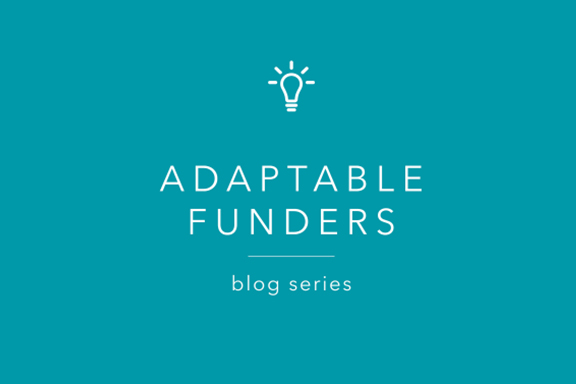
This post in our Adaptable Funder series focuses on community foundations, with an interview with Paul Grogan, President and CEO of the Boston Foundation (TBF). As the full scope of the COVID-19 crisis came into focus, few in philanthropy were as close to the front lines as community foundations. The depth and breadth of the inequities US community foundations had been tackling became clearer to others, and when the rising hum of demand for social justice and racial equity turned into a roar in late May, community foundations again were looked to as resources for insight as well as outreach and support.
Of the approximately 800 community foundations in the US, the Boston Foundation has become an acknowledged leader and mentor as the entire sector responds to current crises while also preparing for the long term. The Boston Foundation was launched in 1915, its early work focusing on those struggling economically in Greater Boston. In 1960, a large bequest enabled the Foundation to become more proactive, providing seed funding for new ideas and nonprofits, extending its reach more solidly into education, health, housing, jobs, and the arts. In the wake of unrest in the city in following decades, TBF launched anti-poverty and social justice initiatives, and attracted new donors while changing its structure for more stable footing. Paul Grogan took the reins in 2001, leveraging his experience in government, academia, and community development to transform TBF into a major civic leader focused not only on support for those in need but also on high-impact initiatives including legislative reform for systemic change in health care, education, and housing. As Paul notes, the evolution of the Foundation into a national thought leader and trusted activist organization enabled its quick and powerful crisis response this year. We hope the insights into TBF’s approach and strategies, both before and in response to the pandemic, spark ideas not only within philanthropic circles but also within broader communities seeking to rally and unify key partners in the weeks and months ahead.
—
TPI: Looking back, what structures and principles do you think were already in place that best prepared the Foundation for crisis response in 2020?
Paul: First, I’d like to say that community foundations all over the country showed agility in responding to crisis. Our assets are designated for the community, often with emergency funding provisions, and we are rooted in local partnerships, so we are in a position to respond very quickly. For example, when the shutdown first began in Boston we heard that so many businesses were being thrown into jeopardy. We were able to put together a program almost overnight, and saved about a hundred small businesses right away.
Boston is a town with a lot of resources, and we had forged deep partnerships with local and state government as well as nonprofits and other leaders in recent years. We are an older foundation and a permanent institution. We aren’t going anywhere and have matured with the city, so we were able to be flexible and imaginative. What’s helped here is a real collegiality that has developed. It’s not the turf battle that may exist elsewhere. We know nobody makes change all by themselves.
It was very, very important that groups proximate to the pain get listened to. Community foundations can and need to play the role of convenor to help build a robust civic realm steeped in trust. That’s been part of what we are working on with other community foundations across the country. At the Boston Foundation we’ve worked hard to ensure that if we call a meeting, people come and engage. And now when people can’t get together in person, so many forums and seminars are still going forward – people are participating virtually, sharing ideas, and building connections all across the country.
The use of data has also been significant for us. We have Boston Indicators, the research center at the Boston Foundation, which works to advance a thriving Greater Boston by analyzing key indicators of well-being and researching issues like affordable housing and the wealth divide, and now the effects of COVID-19. Boston Indicators’ reports give people the power and influence to call for change and a path for action, which will certainly help as we work toward lasting systemic change after the pandemic.
And of course our staff, including program officers who each handle one or more of our Strategic Focus Areas, are critical. We maintain intense relationships with grantees as well as partnerships with government, the business community, and other funders. Our staff is the hub for the sharing of ideas and opportunities. And our board has been open and supportive. So, we were able to respond by being flexible with existing programs, and with prompt emergency grants and new programs, all informed by insights from grassroots community leaders.
TPI: So how did you respond as each crisis hit, and what are any lessons learned so far?
Paul: One thing we need to acknowledge is that this year constitutes multiple crises unfolding on a scale we haven’t seen since the Great Depression. It’s a public health crisis that spurred an economic crisis, layered with racial turmoil, affecting every individual across the country. As soon as we realized the magnitude of the pandemic, and the fact that getting critical information needed to make decisions was going to be a challenge on all levels, we held a series of public forums to learn what we needed to know to take action.
Based on this input, we asked ourselves right away, “Can we turn up the dial?” The risk to expand and accelerate existing ventures seemed worth it. The second week of March 2020 we launched the COVID-19 Response Fund at the Boston Foundation, and we already had a healthy inventory of nonprofits working in intersecting circles that needed more funding. Our vast network of grantee partners around Greater Boston, built over decades, helped us reach the people and organizations who most needed support right away. We’ve now raised more than $12 million and have turned it around to hundreds of organizations providing food and housing, health care, and education, as well as nonprofits enriching the region through arts and culture. Not only were we able to get grants out the door in record time, but we also streamlined the process so that nonprofits could receive unrestricted support and not be burdened with reporting requirements to the Foundation.
We worked hard to educate ourselves and others in the community as the crises unfolded, leaning into our role as convenor and civic leader. We participated in and led forums on equity in public health as early as March, and in April our Business Equity Fund joined a coalition to support vulnerable Black and Latinx business owners. We’ve reached out to educators grappling with digital tools and distance learning, and who work with students whose families have few resources and so many needs right now. We accelerated our Open Door grants, which is how we accept unsolicited proposals and find new and innovative opportunities. In early June, our Latino Legacy Fund and Equality Fund announced grants that had been in process, and we released the Racial Equity Capacity Builders Directory as a resource for the community. And we have continued to publish reports that are all the more important in light of events, focusing on racial discrimination against renters, opportunities around guaranteed income, and other critical issues.
As for lessons, it’s too early to tell what difference we are making, except to know that, due to our ability to make cash grants, more people will be okay. But we are tracking it all and will be able to share findings and lessons as time goes on.
TPI: What are you anticipating long-term?
Paul: We are very aware that every decade or so there has been upheaval, and Boston has not always been able to sustain progress, especially around the wealth gap and economic mobility. Every city has a matrix of organizations and individuals, many moving in and out of different roles over time. Yet as a permanent institution, the Boston Foundation has the opportunity to stay with these issues, to maintain the energy for change. Our institution is embedded even as the players change. I think that’s the biggest job ahead, for us and other community foundations, to take the momentum and to really define success not only by money handed out, but by the impact resulting from our civic leadership, our convening power, and our collaborative partnerships.
Our COVID-19 response postponed tackling a lot of issues that need attention, like workforce development. Boston is headed toward a very severe labor shortage, and our school system is not producing graduates to make up an adequate talent pool. We are raising that banner with education leadership to bring attention to how serious an issue it is. We are already involved in workplace training. The Boston Foundation is getting much closer to businesses and their needs these days, creating new partnerships, so that we can all be as prepared as possible for the tightest labor market ever.
In addition, all of Boston’s population growth over the past decade has come through immigration, so as part of what we do, everyone needs to understand that the racial makeup of our city is changing. We need a massive English as a Second Language program. There’s a direct relationship between improvements in literacy within any community and its success. Now we have to think even more intentionally and creatively than ever about how to tackle issues in ways that make a lasting difference.
TPI: What do you think the Boston Foundation and other community foundations can do, even in crisis, to become even stronger funders and partners in the future?
Paul: What we have done over the years, which we will continue to build on, is focus on how the Boston Foundation can move the needle. The Boston Foundation was there at the beginning of so many of the city’s institutions with seed capital – it’s really an astonishing catalog. We have gotten more strategic over time, choosing one transformational idea within each set of programmatic categories in which we work. We make sure most of the resources go there, and we don’t designate ideas or issues as priorities unless our involvement specifically can make a difference.
We’ve operated under that strategy for a while with a program area-targeted approach. And while we’ve had great impact, we realized a few years ago that this way of focusing our work was making it hard for nonprofits to get a grant if they aren’t currently aligned with the strategies, goals, and approaches pursued in the Foundation’s five Impact Areas. So, we created the Open Door Grants program specifically for organizations outside of our transformational focus, but that still fall under our program areas, that are doing things that could matter in addressing the most critical challenges and biggest opportunities facing our community. High-impact philanthropy, real change over the long-term. That’s what we want to keep doing.
We are privileged to manage a significant flow of money. Right now, the Boston Foundation has some $1.2 billion of assets under management. We work with donors on trends and best practices, like providing unrestricted resources that can be critical to move a coherent program forward. If you have a smart board with financial expertise, like we do, and you equip knowledgeable staff with flexible resources, the difference in what you are able to do is stark. This year we’ve been able to do a lot of radical things quickly, to be a distribution system for good.
You know, every board of directors always tells its organization, “You’re trying to do too much.” At the Boston Foundation, we struggle with that, but we always point to instances where we had an opportunity for moonshot thinking and we made a difference. It’s a great thing to know that, as much as we have done, the work being done by community foundations right now on the most important issues of our time, if we continue this trend, will not only benefit our communities, but will also be a contribution to our country.
—
The Boston Foundation’s experiences reinforce the importance of viewing philanthropy as more than financial gifts. Funders have the ability – through careful listening and strategic partnerships – to be in the right place at the right time to offer a unique contribution in the formation of solutions and systems change. And community foundations are ideally positioned to lead this work at the local level. You can learn more about the Boston Foundation’s work here, and about TPI’s work supporting community foundations here.
TPI operates nationally and globally, and is housed at the Boston Foundation.


